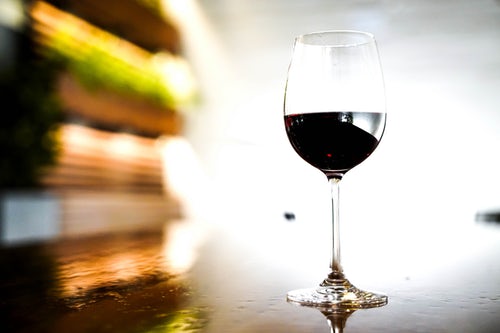One of the problems with .05 is that not many of us can tell if we’re under, at, or over that limit. The safest method, of course, is not to drive if you’ve had anything at all to drink, but that’s not always possible or practical.
ALL THOSE CHARTS AND pieces of advice about how affected you are by what you’ve had to drink are more confusing than enlightening: women shouldn’t drive if they’ve had more than one standard drink in the first hour and then one every hour after that; men, we are told, can have two standard drinks in the first hour and then need to limit themselves to one drink each hour thereafter.
The first thing to learn is what constitutes a “standard drink” and you may be quite surprised at how little is involved. On a flight back from Melbourne recently, the flight attendant offered me a second tiny bottle of red wine. Luckily, I checked the rating on the label and realised it constituted 2.1 standard drinks. Had I drunk the second bottle and then put myself behind the wheel, there was a good chance I would have been over the limit. And how many of us, at home, pour such a meagre amount into a glass?
So, a standard drink is 100ml of sparkling wine… that’s right, probably two thirds of what we’d all consider a fairly miserly serve. Same with white or red wine; 100ml is a standard drink. That means you’d get seven and a half glasses of wine from a standard 750ml bottle. Not in my house! Normal strength beer (4.9% alcohol) means you can drink two 285ml glasses in an hour (if you’re a bloke, just one if you’re a woman). Even the smaller bottles we’re rapidly becoming used to are 330ml, so two of those in an hour and you’re heading for trouble. It’s even worse if you’re a fan of port or other fortified wines: 60ml is a standard drink and spirit drinkers are looking at a tiny 30ml as a standard drink.
To further complicate matters, there are a number of other factors that will have an effect on your blood alcohol limit (the amount of alcohol present in your body measured as grams of alcohol per 100ml of blood – a standard drink contains 10 grams of pure alcohol). A smaller or lightly built person will have a higher blood alcohol content than a larger person because the alcohol is concentrated into a smaller body mass. Food in the stomach slows the rate at which alcohol passes into the bloodstream, but it will get there eventually. More bad news for the fatties: people with higher body fat levels will have a higher BAC because alcohol isn’t absorbed into fatty tissue. And sorry ladies, but women will almost always have a higher BAC than a man after drinking the same number of drinks.

Things get even more complicated again because the alcohol content of drinks will vary. It’s difficult to tell how much alcohol is in mixed drinks, and wine alcohol content can vary considerably so it is easy to find yourself inadvertently over the limit. As we said, the only safe level of drinking to ensure you aren’t over the limit is no alcohol at all.
HOW DRUNK ARE YOU?
We’ve all seen horror stories about people drink driving with frightening levels of alcohol in their blood (I almost said “blood in their alcohol” and in some cases, this isn’t far from the truth). Some of them happily argue that they are so inured to the effects of alcohol that it has little effect on their ability to drive, problem drinkers who believe they are so used to driving drunk that it has no impact on their driving. So, how drunk is drunk?

0.02-0.03: Most of us would have trouble recognising any effects of alcohol at this level. There is no loss of coordination, a slight sense of euphoria and a decrease in shyness. At most, we’d feel mildly relaxed and a little light-headed.
0.04-0.06: This is the sweet spot for drinkers, providing a feeling of well-being. Inhibitions are lowered and there is a sense of relaxation. However, the effect on driving ability is already starting to show with slightly impaired judgement, minor impairment of reasoning and memory and less caution. Responsible people start to consider not driving when they reach this level.
0.07-0.09: Anybody who reaches this level of inebriation will suffer some degree of impairment, whether they recognise it or not. Driving skills are impaired and reaction times are notably slower. Balance, speech and hearing are all affected. The upside is at this level, some people start to experience feelings of euphoria. Between 0.03 and 0.12 (depending on the factors listed above), a drinker gets a boost in self-confidence, often becoming the life of the party. Others will notice a flushed appearance, a short attention span and poor judgement.
0.10-0.12: At this level, significant impairment of motor skills becomes evident. There is loss of coordination and judgement is severely affected (which is why people often decide to drive at this level of inebriation when at lower levels they make a sensible decision not to). Speech may be slurred; balance, vision, reaction time and hearing are all adversely impacted. People at this level have trouble understanding things, their movements are uncoordinated and they may start to feel a little sleepy.
0.13-0.15: Okay, now there’s no question: You’re drunk. You’re suffering severe lack of judgement, perception and your motor skills are extremely impaired. At this point, according to the statistics, your chances of being involved in a fatal crash (and it may not be you that dies) are 380 times higher than if you were driving sober.
0.16-0.19: The drinker has now moved into the stage of being a “sloppy drunk” – the one who spills his or her drink on you, stumbles into you, or falls off the chair. At this level, most drinkers will feel incapacitated to some degree. Some social drinkers will pass out at this level. Unfortunately, this is also the level of drunkenness when aggression begins. Conversely, some drunks become highly emotional or affectionate. None of these behaviours is attractive. It is also the point at which a drinker starts becoming indifferent to pain, making an aggressive drunk at this level very difficult to handle, especially since they are immune to rational persuasion.
0.20: This is the point at which a drunk is quite literally “out of it”. The drunk exhibits signs of confusion, dizziness and needs help to stand or walk. Nausea and vomiting are probable and blacking out is also likely, which may be the best possible outcome for all concerned.
0.25: At this level of BAC, all mental, physical and sensory functions are severely impaired. There is near total loss of motor function control and a very real risk of asphyxiation from choking on vomit. Loss of motor function control includes bladder and sphincter control. Loss of consciousness is very probable and the drunk becomes unresponsive to stimuli.
0.30-0.40: This is the stage at which stupor is the most likely response. The drinker is at a very real risk of dying. If he or she passes out (highly probable), they may be difficult to awaken and may quickly pass into a coma. Reflexes are depressed, body temperature drops, breathing becomes shallow and the heart rate slows. A drunk at this level of inebriation is in a similar state to a patient under surgical anaesthesia.
0.45 and above: Most people will die.
